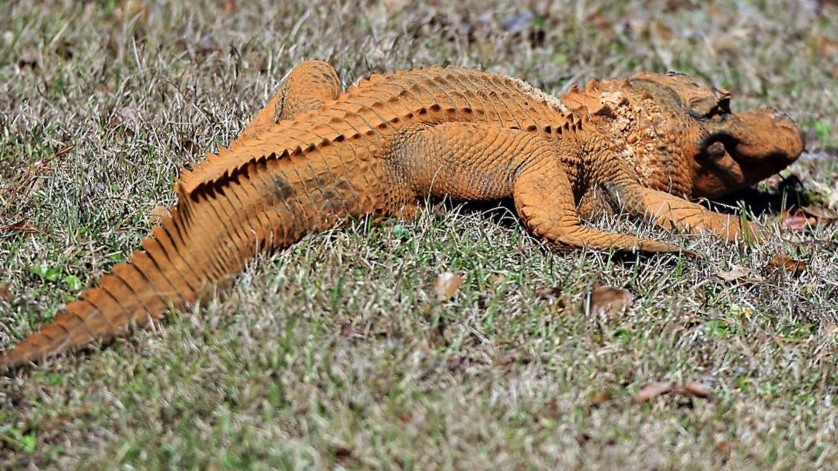Crocodiles and gharials are getting bizarre orange 'tans' in Nepal. Here's why.
Researchers think it could be down to where these crocs are hanging out.

Freshwater mugger crocodiles and gharials are turning orange in Nepal, and scientists think it's down to iron in the waters where they hang out.
The orange crocs were spotted in Chitwan National Park, a protected area of the Himalayan foothills. "Have these crocs been drinking too much Sunny D? Messily eating Cheetos? Or could they be taking fashion advice from Donald Trump?" Phoebe Griffith, a postdoctoral researcher at the Leibniz Institute of Freshwater Ecology and Inland Fisheries, wrote in a Twitter thread on May 29.
To find out why the crocs have become tangerine-colored, researchers collaborated with Project Mecistops — a conservation project working to preserve and reintroduce critically endangered West African slender-snouted crocodiles (Mecistops cataphractus) in Côte d'Ivoire and throughout western Africa.
It turns out some of the rivers and streams in the park have extremely high levels of iron, which could explain why some crocodilians are sporting orange coats.
"Gharial and mugger crocodiles who spent lots of time in some streams, or near the mouths of them, were getting a serious fake tan," Griffith explained on Twitter. "Turns out some areas of Chitwan have seriously high levels of iron in the water, and iron reacts with oxygen to form an orange substance called iron oxide."
Related: How are alligators and crocodiles different?
Have these crocs been drinking too much Sunny D? Messily eating Cheetos? Or could they be taking fashion advice from Donald Trump? (is that one wearing a Make Chitwan Great again cap?). Nope - seems to be all about where they’re hanging out! An orange croc thread 1/3 #scicomm pic.twitter.com/KA93d3wrOSMay 29, 2023
As these crocs spend most of their time in the water — gharials are not well-suited to walking on land and typically only crawl onto sandbanks to bask in the sun or nest — the iron-rich rivers could have coated their scales and teeth in a temporary layer of rusty particles.
Sign up for the Live Science daily newsletter now
Get the world’s most fascinating discoveries delivered straight to your inbox.
Gharials (Gavialis gangeticus) are critically endangered freshwater crocodiles that have a long, narrow snout tipped with a bulbous growth. Males can grow to be around16 feet (5 meters) long and weigh up to 550 pounds (250 kilograms).
The gharial population in Nepal has plummeted by 98% since the 1940s due to overhunting, according to the Zoological Society of London. Most of the 200 remaining gharials live in Chitwan National Park, where they face additional threats linked to pollution, mining and declining fish populations.
Mugger crocodiles (Crocodylus palustris) are more widespread and inhabit marshes and waterways stretching from southern Iran to the Indian subcontinent. They are broad-snouted and similar in size to gharials, but they can weigh twice as much due to their girth.
… and yep! Turns out some area of Chitwan have seriously high levels of iron in the water, and iron reacts with oxygen to form an orange substance called iron oxide. I loved these orange crocs as this is my favourite colour (she said, scientifically). 3/3 #wildlife #crocodiles pic.twitter.com/yLfPLXZywIMay 29, 2023
The discolored gharials’ and crocodiles’ new orange look is temporary, and the rusty particles could wash off in less iron-rich waters. "It should go off automatically in clean(er) water," Lala Aswini Kumar Singh, a zoologist and wildlife researcher in India, wrote in a comment on Twitter.
These aren't the first rust-colored reptiles on record. A 2016 study in the African Journal of Ecology reported that orange dwarf crocodiles (Osteolaemus tetraspis) living in caves in Gabon may have turned orange after being exposed to bat guano, which contains high levels of urea — a substance with a bleaching effect that forms when protein is broken down in the liver.
Iron oxide may also have tinted an orange-hued alligator in South Carolina in 2017, after it spent the winter in a rusty iron culvert.

Sascha is a U.K.-based staff writer at Live Science. She holds a bachelor’s degree in biology from the University of Southampton in England and a master’s degree in science communication from Imperial College London. Her work has appeared in The Guardian and the health website Zoe. Besides writing, she enjoys playing tennis, bread-making and browsing second-hand shops for hidden gems.










